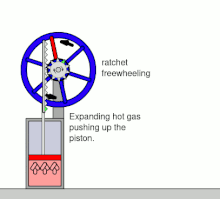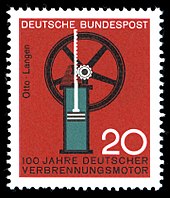Aviation piston engine
A flying piston engine or atmospheric engine from Otto and Langen is an engine in which the piston transmits its energy via a rack and not via a crank drive.
Working principle
In the standing, open-top single-cylinder engine, the piston flies upwards after the gas-air mixture has been introduced and ignited. The rack is decoupled from the drive by a freewheel during the upward movement. In this way, the destructive effect of the impacts on the drive mechanism caused by the explosive combustion is avoided. Only when the piston goes back - triggered by the higher pressure of the surrounding air (atmosphere) in relation to the combustion gas, which is rapidly cooling in the combustion chamber, and to a lesser extent also by its own weight - is the piston rod connected to the drive shaft by the now closed freewheel, and the desired Rotational movement is generated. Because the power output depends on the cooling of the combustion gases, the ignition frequency is limited and the power is considerably lower compared to a four-stroke engine of comparable size. The gas-air mixture must be introduced into the combustion chamber, there is no intake process, nor is there any pre-compression. In return, however, combustion takes place with every piston stroke and thus power is output.
At maximum power, the piston moves up and down with every revolution of the shaft. The lowering of the piston can be delayed by regulating the exhaust system. Since the cycle only starts again when the piston has completely dropped and the shaft is in the correct position, regulating the exhaust system means that the engine does not have to start a cycle with every revolution. This allows the power of the motor to be regulated downwards. (Since the remaining aviation piston engines are only operated in museum operation and in idle, the shaft typically makes several revolutions between two piston strokes)
The aviation piston engine is a technical specialty within the piston engine because of its missing crankshaft .
history
As the name suggests, the engine was developed by Nikolaus Otto and Eugen Langen in the company NA Otto & Cie. Founded by the two in 1864.
The engine was presented to the public for the first time at the World Exhibition in Paris in 1867 . This new engine development had a third of the fuel consumption of the previously known engines by Étienne Lenoir . She was awarded a gold medal. By the time the Otto four-stroke engine was launched on the market in 1876, almost 5000 Otto Langen flying piston engines were built by Deutz AG and its licensees.
The motor shown at the world exhibition had 0.5 HP at 80 revolutions per minute. This engine was sold straight away from the exhibition, but was bought back by Eugen Langen as a collector's item as early as 1875.
The Crossley Brothers licensed the patents for the atmospheric gas engine in 1869 and produced approximately 1,300 engines over the course of 10 years.
In 1964, the Deutsche Bundespost issued a 20-pfennig special stamp showing an aviation piston engine.
Web links
literature
- Gustav Goldbeck: Power for the World, 1864–1964 Klöckner-Humboldt-Deutz AG , Econ, Düsseldorf 1964, DNB 451601769 .
- Eugen Diesel, Gustav Goldbeck, Friedrich Schildberger: From the engine to the car. 5 men and their work: Otto, Daimler, Benz, Diesel, Bosch . Association of Friends of the Technical University of Stuttgart, 3rd edition, DVA, Stuttgart 1968, DNB 456458905 .





